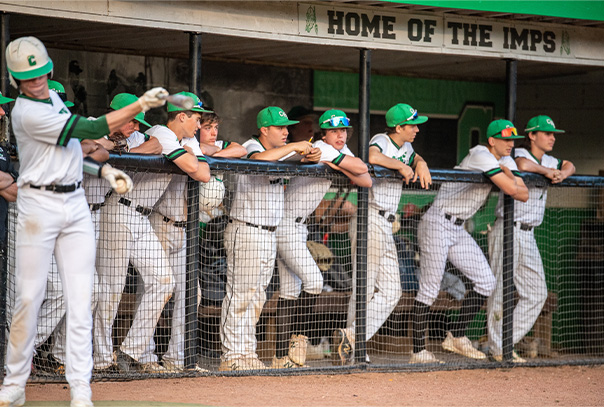 College baseball is my favorite. The conclusion of the regular season yields conference tournaments where the excitement really starts to build. Tons of great baseball to watch and enjoy. Then regionals are held, and as the stakes are raised, the games bring out the best, as well as the worst, of our sport. Of course—and rightfully so—everyone is watching: the 10-year-old kid, the 16-year-old player and everyone else who loves this great game. So as our sport continues to grow in popularity, it has a tremendous responsibility.
College baseball is my favorite. The conclusion of the regular season yields conference tournaments where the excitement really starts to build. Tons of great baseball to watch and enjoy. Then regionals are held, and as the stakes are raised, the games bring out the best, as well as the worst, of our sport. Of course—and rightfully so—everyone is watching: the 10-year-old kid, the 16-year-old player and everyone else who loves this great game. So as our sport continues to grow in popularity, it has a tremendous responsibility.
The goal of any player, coach, or program is to “leave things better than you found them.” We see this point echoed with clips of players in all sports, picking up trash or cleaning up a court or dugout, a classy move that all appreciate. This raises the question as to why the player's conduct between the lines doesn’t get held to the same standard. Excuses flow. “Kids are different today.” “Everyone is doing it.” “Big leaguers have K struts, sheath swords, bat flip, watch home runs, etc. Why can’t we?”
News flash: the kids are not different, what we tolerate is different. As a high school player, we would get excited over a big play by pumping our fists. We weren’t allowed by our coach to direct dugout chatter to the other team. Today, it's not the same, everything is personal. It's not enough to win, you have to let your opponent know you are beating them. This does raise the intensity. If the game goes back and forth, the antics—often in retaliation—get even more severe. In college, especially as a pitcher, there is down time and it's passed by chirping and cutting up. It’s useful when this energy is directed at your own team, and detrimental when directed at the opponent. That was what Division I baseball used to be—when guys made it personal, benches cleared. I was told as a Sunday starter to police stealing and bunting up 10 runs from the game before—on more than one occasion. We had some heated exchanges. Tempers flared, but to me, that's part of the competitive game. Bat flips in 2004 weren’t a huge thing. I knew if I gave the batter a glove signal or waived at him I was coming out. Sparks were already there, making great rivalries.
This past spring, in the regional, we saw bats being thrown 30-40 feet. Players flicking off the opposing team. People getting fired up that umpires are (physically) nudging hitters to run around the bases on home runs. Many weighed in with a consensus view, and I see your point, that the other way around with a player touching an ump is an ejection. The difference is the umpire is the authority figure. The fact we have an umpire shortage speaks to how we treat umpires. No one wants to do it. Respect for authority is lacking. Authority in the dugouts can absolutely stop the extreme showmanship. It requires consistency. It requires a care level that extends beyond the result of your next game. It's about how we are going to win. I, for one, have always viewed sportsmanship as the “nice guy award.” It's the team who gets pounded all season but stays positive and handles defeat with grace. The reality is it's also the team that wins and does so with integrity.
What does winning with integrity look like? It’s simple. Have fun, get excited about your team/your guys, but don’t make things personal with the other team.
I get that making it personal can make it fun, but at what cost? In a short high school or college season (30 to 60 games) you need energy and passion and this keeps guys “in the game.” The MLB season is much longer and much harder to maintain that passion for 162 games. The challenge here is to teach the why and the how. Why shouldn't it be done this way? How should it go? We need to model it, reward it, and make it fun. It's not an easy fix. It takes intentionality and goes against the grain. The stakes are always high. Transfer portals and NIL money have created new issues, and new opportunities.
We, as stewards of the game, have to decide what we will allow. Where is the line? We have to get together and figure out how to police ourselves and right this ship so the personal attacks are removed. Enough with the bat throws across the field by players and even coaches in some instances. Enough with showing up your opponent. Hold your players to a standard and teach them a life lesson. They represent themselves, their families, their coaches, their programs, and their communities. Get baseball back to the great game and not the sideshow. Watch it thrive even more. That is sustainable.
Since the beginning of his high school head coaching career in 2007, Jonathan Gehris (ABCA Region 2 Organizational Committee Chair, NCBCA All State Committee, M.Ed, AIC, CIC, CSS, FMS, FT, PT) has guided 68 players to the college baseball ranks and had four former players sign professional contracts. He’s coached three high school All-Americans and 11 All-State players. He has led previous schools to a pair of state championship appearances and one state title. He is a 16-year member of the ABCA.